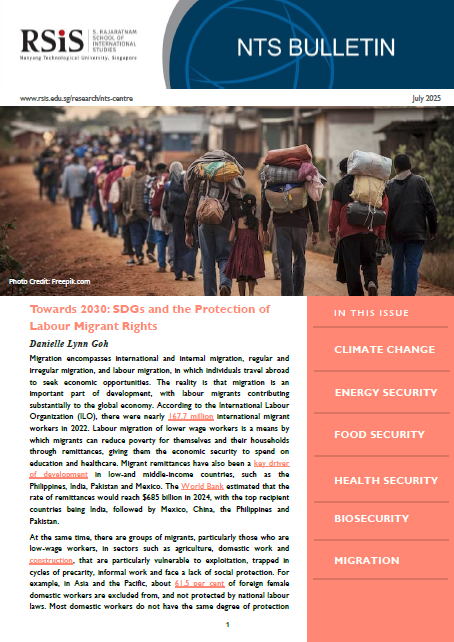24 July 2025
- RSIS
- Publication
- RSIS Publications
- NTS Bulletin July 2025
Migration encompasses international and internal migration, regular and irregular migration, and labour migration, in which individuals travel abroad to seek economic opportunities. The reality is that migration is an important part of development, with labour migrants contributing substantially to the global economy. According to the International Labour Organization (ILO), there were nearly 167.7 million international migrant workers in 2022. Labour migration of lower wage workers is a means by which migrants can reduce poverty for themselves and their households through remittances, giving them the economic security to spend on education and healthcare. Migrant remittances have also been a key driver of development in low-and middle-income countries, such as the Philippines, India, Pakistan and Mexico. The World Bank estimated that the rate of remittances would reach $685 billion in 2024, with the top recipient countries being India, followed by Mexico, China, the Philippines and Pakistan.
At the same time, there are groups of migrants, particularly those who are low-wage workers, in sectors such as agriculture, domestic work and construction, that are particularly vulnerable to exploitation, trapped in cycles of precarity, informal work and face a lack of social protection. For example, in Asia and the Pacific, about 61.5 per cent of foreign female domestic workers are excluded from, and not protected by national labour laws. Most domestic workers do not have the same degree of protection and coverage as found in other occupations or sectors.
Migration is a cross-cutting issue across the SDGs, with all 17 goals comprising targets and indicators that are relevant to migration and mobility. Ensuring that the rights of migrants are protected is integral to actualising the 2030 Agenda for Sustainable Development. Under SDG10 (Reduced inequalities), target 10.7 aims to “facilitate orderly, safe, regular and responsible migration and mobility of people”. In SDG8 (Economic growth and decent work), measures to eliminate forced labour and trafficking, and the protection of labour rights for migrant workers are included as indicators. Climate change also impacts migrants, with climate-related disasters such as flooding and droughts resulting in displacement or forced migration, and it is estimated that between 50 to 250 million people could be displaced by 2050 as a result of climate change. Alongside the SDGs, the Global Compact for Safe Orderly and Regular Migration (GCM) comprises 23 objectives to foster international cooperation on global migration governance.
To improve the economic and social protection of low-wage migrant workers, the development of skills of low-wage migrant workers can aid in poverty reduction and expand career pathways for labour migrants. Governments and NGOs in destination countries should work towards providing more avenues for upskilling in industry-related courses such as caregiving, digital literacy and language learning. Skills recognition, certification and accreditation, that includes both informal and formal learning, allows for migrant workers to better access job opportunities that match their skills. The International Organization for Migration (IOM) highlighted in its publication on measuring the progress of migration and the SDGs, that recruitment costs have remained high for migrant workers. To tackle this, governments can intervene, for example through standard contracts signed by employers, recruiters and workers, to ensure that migrant workers do not bear the costs of hefty recruitment fees, driven by illegal recruitment practices that often result in debt bondage. States also need to ensure that migrant workers are adequately protected in terms of remuneration, conditions of work, rights to leave and rest, access to dispute resolutions and social protection provisions within their employment contracts.
Governments must take a more inclusive and nuanced approach in their policies on migration. In the review of migration-related indicators, a disaggregation of data by income, gender, age, race, ethnicity, disability and migratory status is needed for more meaningful and comparable data that can provide a clearer understanding of the progress made in relation to migration within the SDGs. Ultimately, the underlying perceptions and anxieties surrounding migration must be addressed. States and local populations must recognise the economic contributions of migrants, and their role in development of both ‘sending’ and ‘receiving’ countries. Advancing the protection of migrants through the implementation of human rights treaties, ILO conventions and regional commitments, is key to progress in the SDGs.
Migration encompasses international and internal migration, regular and irregular migration, and labour migration, in which individuals travel abroad to seek economic opportunities. The reality is that migration is an important part of development, with labour migrants contributing substantially to the global economy. According to the International Labour Organization (ILO), there were nearly 167.7 million international migrant workers in 2022. Labour migration of lower wage workers is a means by which migrants can reduce poverty for themselves and their households through remittances, giving them the economic security to spend on education and healthcare. Migrant remittances have also been a key driver of development in low-and middle-income countries, such as the Philippines, India, Pakistan and Mexico. The World Bank estimated that the rate of remittances would reach $685 billion in 2024, with the top recipient countries being India, followed by Mexico, China, the Philippines and Pakistan.
At the same time, there are groups of migrants, particularly those who are low-wage workers, in sectors such as agriculture, domestic work and construction, that are particularly vulnerable to exploitation, trapped in cycles of precarity, informal work and face a lack of social protection. For example, in Asia and the Pacific, about 61.5 per cent of foreign female domestic workers are excluded from, and not protected by national labour laws. Most domestic workers do not have the same degree of protection and coverage as found in other occupations or sectors.
Migration is a cross-cutting issue across the SDGs, with all 17 goals comprising targets and indicators that are relevant to migration and mobility. Ensuring that the rights of migrants are protected is integral to actualising the 2030 Agenda for Sustainable Development. Under SDG10 (Reduced inequalities), target 10.7 aims to “facilitate orderly, safe, regular and responsible migration and mobility of people”. In SDG8 (Economic growth and decent work), measures to eliminate forced labour and trafficking, and the protection of labour rights for migrant workers are included as indicators. Climate change also impacts migrants, with climate-related disasters such as flooding and droughts resulting in displacement or forced migration, and it is estimated that between 50 to 250 million people could be displaced by 2050 as a result of climate change. Alongside the SDGs, the Global Compact for Safe Orderly and Regular Migration (GCM) comprises 23 objectives to foster international cooperation on global migration governance.
To improve the economic and social protection of low-wage migrant workers, the development of skills of low-wage migrant workers can aid in poverty reduction and expand career pathways for labour migrants. Governments and NGOs in destination countries should work towards providing more avenues for upskilling in industry-related courses such as caregiving, digital literacy and language learning. Skills recognition, certification and accreditation, that includes both informal and formal learning, allows for migrant workers to better access job opportunities that match their skills. The International Organization for Migration (IOM) highlighted in its publication on measuring the progress of migration and the SDGs, that recruitment costs have remained high for migrant workers. To tackle this, governments can intervene, for example through standard contracts signed by employers, recruiters and workers, to ensure that migrant workers do not bear the costs of hefty recruitment fees, driven by illegal recruitment practices that often result in debt bondage. States also need to ensure that migrant workers are adequately protected in terms of remuneration, conditions of work, rights to leave and rest, access to dispute resolutions and social protection provisions within their employment contracts.
Governments must take a more inclusive and nuanced approach in their policies on migration. In the review of migration-related indicators, a disaggregation of data by income, gender, age, race, ethnicity, disability and migratory status is needed for more meaningful and comparable data that can provide a clearer understanding of the progress made in relation to migration within the SDGs. Ultimately, the underlying perceptions and anxieties surrounding migration must be addressed. States and local populations must recognise the economic contributions of migrants, and their role in development of both ‘sending’ and ‘receiving’ countries. Advancing the protection of migrants through the implementation of human rights treaties, ILO conventions and regional commitments, is key to progress in the SDGs.





